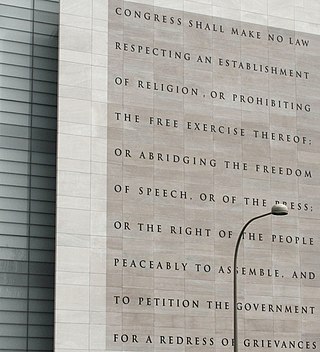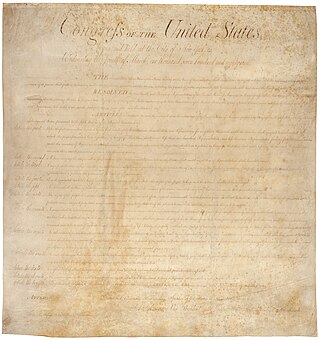Related Research Articles

The First Amendment to the United States Constitution prevents the government from making laws that regulate an establishment of religion, or that prohibit the free exercise of religion, or abridge the freedom of speech, the freedom of the press, the freedom of assembly, or the right to petition the government for redress of grievances. It was adopted on December 15, 1791, as one of the ten amendments that constitute the Bill of Rights.
Hustler Magazine, Inc. v. Falwell, 485 U.S. 46 (1988), is a landmark decision by the Supreme Court of the United States in which the Court held that parodies of public figures, even those intending to cause emotional distress, are protected by the First and Fourteenth Amendments to the U.S. Constitution.

Hill v Church of Scientology of Toronto February 20, 1995- July 20, 1995. 2 S.C.R. 1130 was a libel case against the Church of Scientology, in which the Supreme Court of Canada interpreted Ontario's libel law in relation to the Canadian Charter of Rights and Freedoms.
In United States defamation law, actual malice is a legal requirement imposed upon public officials or public figures when they file suit for libel. Compared to other individuals who are less well known to the general public, public officials and public figures are held to a higher standard for what they must prove before they may succeed in a defamation lawsuit.
New York Times Co. v. Sullivan, 376 U.S. 254 (1964), was a landmark U.S. Supreme Court decision ruling that the First Amendment to the U.S. Constitution's freedom of speech protections limit the ability of American public officials to sue for defamation. The decision held that if a plaintiff in a defamation lawsuit is a public official or candidate for public office, not only must they prove the normal elements of defamation—publication of a false defamatory statement to a third party—they must also prove that the statement was made with "actual malice", meaning the defendant either knew the statement was false or recklessly disregarded whether it might be false. New York Times Co. v. Sullivan is frequently ranked as one of the greatest Supreme Court decisions of the modern era.
Gertz v. Robert Welch, Inc., 418 U.S. 323 (1974), was a landmark decision of the US Supreme Court establishing the standard of First Amendment protection against defamation claims brought by private individuals. The Court held that, so long as they do not impose liability without fault, states are free to establish their own standards of liability for defamatory statements made about private individuals. However, the Court also ruled that if the state standard is lower than actual malice, the standard applying to public figures, then only actual damages may be awarded.

In the United States, freedom of speech and expression is strongly protected from government restrictions by the First Amendment to the U.S. Constitution, many state constitutions, and state and federal laws. Freedom of speech, also called free speech, means the free and public expression of opinions without censorship, interference and restraint by the government. The term "freedom of speech" embedded in the First Amendment encompasses the decision what to say as well as what not to say. The Supreme Court of the United States has recognized several categories of speech that are given lesser or no protection by the First Amendment and has recognized that governments may enact reasonable time, place, or manner restrictions on speech. The First Amendment's constitutional right of free speech, which is applicable to state and local governments under the incorporation doctrine, prevents only government restrictions on speech, not restrictions imposed by private individuals or businesses unless they are acting on behalf of the government. However, It can be restricted by time, place and manner in limited circumstances. Some laws may restrict the ability of private businesses and individuals from restricting the speech of others, such as employment laws that restrict employers' ability to prevent employees from disclosing their salary to coworkers or attempting to organize a labor union.
Fair comment is a legal term for a common law defense in defamation cases. It is referred to as honest comment in some countries.
In US law, false light is a tort concerning privacy that is similar to the tort of defamation. The privacy laws in the United States include a non-public person's right to protection from publicity that creates an untrue or misleading impression about them. That right is balanced against the First Amendment right of free speech.
A public figure is a person who has achieved fame, prominence or notoriety within a society, whether through achievement, luck, action, or in some cases through no purposeful action of their own.
Milkovich v. Lorain Journal Co., 497 U.S. 1 (1990), was a United States Supreme Court case that rejected the argument that a separate opinion privilege existed against libel. It was seen by legal commentators as the end of an era that began with New York Times Co. v. Sullivan and continued with Gertz v. Robert Welch, Inc., in which the court clarified and greatly expanded the range and scope of what could be said in the press without fear of litigation.
Dun & Bradstreet, Inc. v. Greenmoss Builders, Inc., 472 U.S. 749 (1985), was a Supreme Court case which held that a credit reporting agency could be liable in defamation if it carelessly relayed false information that a business had declared bankruptcy when in fact it had not.
Time, Inc. v. Firestone, 424 U.S. 448 (1976), was a U.S. Supreme Court case concerning defamation suits against public figures.
Bose Corp. v. Consumers Union of United States, Inc., 466 U.S. 485 (1984), was a product disparagement case ultimately decided by the Supreme Court of the United States. The Court held, on a 6–3 vote, in favor of Consumers Union, the publisher of Consumer Reports magazine, ruling that proof of "actual malice" was necessary in product disparagement cases raising First Amendment issues, as set out by the case of New York Times Co. v. Sullivan (1964). The Court ruled that the First Circuit Court of Appeals had correctly concluded that Bose had not presented proof of actual malice.
The origins of the United States' defamation laws pre-date the American Revolution; one influential case in 1734 involved John Peter Zenger and established precedent that "The Truth" is an absolute defense against charges of libel. Though the First Amendment of the U.S. Constitution was designed to protect freedom of the press, for most of the history of the United States, the U.S. Supreme Court failed to use it to rule on libel cases. This left libel laws, based upon the traditional "Common Law" of defamation inherited from the English legal system, mixed across the states. The 1964 case New York Times Co. v. Sullivan, however, radically changed the nature of libel law in the United States by establishing that public officials could win a suit for libel only when they could prove the media outlet in question knew either that the information was wholly and patently false or that it was published "with reckless disregard of whether it was false or not". Later Supreme Court cases barred strict liability for libel and forbade libel claims for statements that are so ridiculous as to be obviously facetious. Recent cases have added precedent on defamation law and the Internet.
Time, Inc. v. Hill, 385 U.S. 374 (1967), is a United States Supreme Court case involving issues of privacy in balance with the First Amendment to the United States Constitution and principles of freedom of speech. The Court held 6–3 that the latter requires that merely negligent intrusions into the former by the media not be civilly actionable. It expanded that principle from its landmark defamation holding in New York Times v. Sullivan.

In the United States, some categories of speech are not protected by the First Amendment. According to the Supreme Court of the United States, the U.S. Constitution protects free speech while allowing limitations on certain categories of speech.

Obsidian Finance Group, LLC v. Cox is a 2011 case from the United States District Court for the District of Oregon concerning online defamation. Plaintiffs Obsidian Finance Group and its co-founder Kevin Padrick sued Crystal Cox for maintaining several blogs that accused Obsidian and Padrick of corrupt and fraudulent conduct. The court dismissed most of Cox's blog posts as opinion, but found one single post to be more factual in its assertions and therefore defamatory. For that post, the court awarded the plaintiffs $2.5 million in damages. This case is notable for the court's ruling that Cox, as an internet blogger, was not a journalist and was thus not protected by Oregon's media shield laws, although the court later clarified that its ruling did not categorically exclude blogs from being considered media and indicated that its decision was based in part upon Cox offering to remove negative posts for a $2,500 fee. In January 2014 the Ninth Circuit Court affirmed in part and reversed in part the district court's judgment awarding compensatory damages to the bankruptcy trustee. It also ordered a new trial on the blog post at issue.
Harte-Hanks Communications Inc. v. Connaughton, 491 U.S. 657 (1989), was a case in which the Supreme Court of the United States supplied an additional journalistic behavior that constitutes actual malice as first discussed in New York Times Co. v. Sullivan (1964). In the case, the Court held that departure from responsible reporting and unreasonable reporting conduct alone were not sufficient to award a public figure damages in a libel case. However, the Court also ruled that if reporters wrote with reckless disregard for the truth, which included ignoring obvious sources for their report, plaintiffs could be awarded compensatory damages on the grounds of actual malice.
Rosenbloom v. Metromedia, Inc., 403 U.S. 29 (1971), was a United States Supreme Court case of libel brought by George Rosenbloom against Metromedia. This case was responsible for establishing the idea that the knowingly and recklessly false standard for defamatory statements should apply to private individuals as well as public officials in matters of public concern. Concluding that the story was a matter of public concern, the Supreme Court ruled that it did not matter that Rosenbloom was a private citizen; however, the evidence provided in the case did not support the damages awarded to Rosenbloom. The decision was made June 7, 1971 with a 5-3 decision.
References
- Camp, Julie Van (2005). "First Amendment". Professor of Philosophy. California State University, Long Beach. Retrieved 1 January 2012.
- Cohen, Henry (16 October 2009). "Freedom of Speech and Press: Exceptions to the First Amendment" (PDF). Legislative Attorney. Congressional Research Service. Retrieved 1 January 2012.
- Volokh, Eugene (2008). First Amendment and Related Statutes: Problems, Cases and Policy Arguments (3rd ed.). Foundation Press (published 12 May 2008). ISBN 978-1-59941-338-9.